Mossdale to Merrick (part 5)
7.89 miles 4h 24m ascent 322m
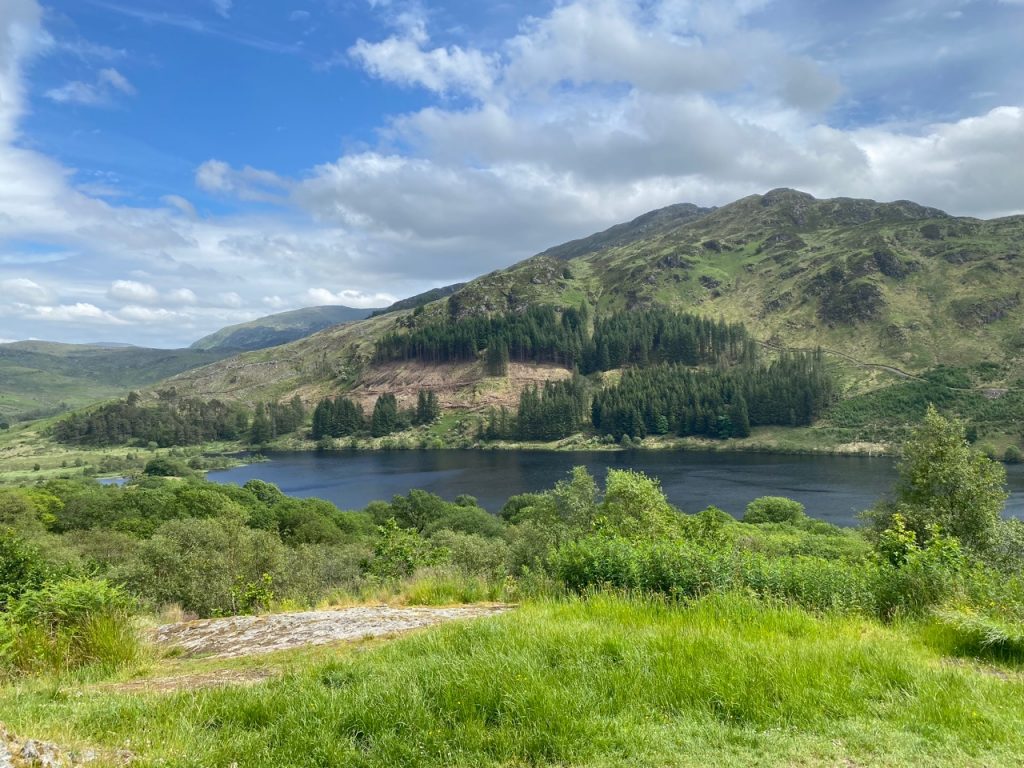
Loch Trool
Loch Trool to Loch Dee
The sixth of our Raiders walks took us from the “treeless waste around the lonely mountain lake”, Loch Dee, to the “sylvan woods and bright verdure” of Loch Trool. We parked below the Fell of Eschoncan near Bruce’s Stone and our route was a simple one, along the track past Glenhead and then the Southern Upland Way as far as the Rosnes Benches above the loch, returning the same way. I had considered starting at Caldons and including a full round of Loch Trool itself but was pleased I didn’t when we found the footpath on the southern side of the loch closed (for felling).
cows on the hill, cold, waterfalls, brishies, two lochs, cow wheat, fritillary
We left our visit to Bruce’s Stone until the return leg and set off immediately along the road towards Buchan and Glenhead, a couple of cyclists passing us as we went. They passed us again in the opposite direction within five minutes leaving us worried that there was some obstruction ahead. There was not. Ours not to reason why. There are cattle gratings along here but they each had gates to shepherd the dogs through.
The track takes walkers across first the Buchan Burn and then the Gairland Burn. Differing styles of bridge span each and the streams themselves are quite different in their appearance. The Buchan is named for the huts which once stood at its foot, the eas bothanach while the Gairland’s name is less certain. The land part likely began as linn, a pool, often one associated with a waterfall. Gair’s origin has been suggested as gar, suggesting near, or gearr, short, but I think its appearance fits better with garbh, rough. There are named Gairies, rough hillsides, above either bank.
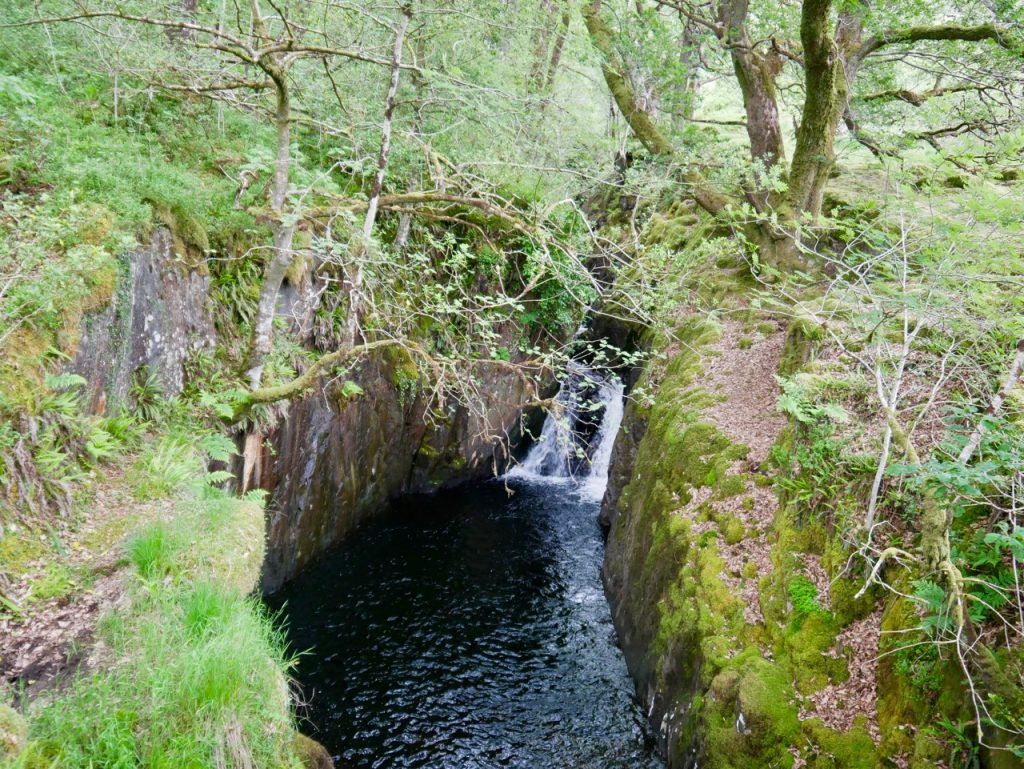
Buchan Burn
Malcolm Harper in 1876 found the Buchan Burn very rocky and extremely wild…Its precipitous sides, profusely clad with moss and lichens and remains much as he described. Harper reports the stone bridge crossing as being inscribed:
Land of brown heath and shaggy wood,
Land of the mountain and the flood,
Land of my sires, what mortal hand
Can e’er untie the filial band
That knits me to thy rugged strand ?
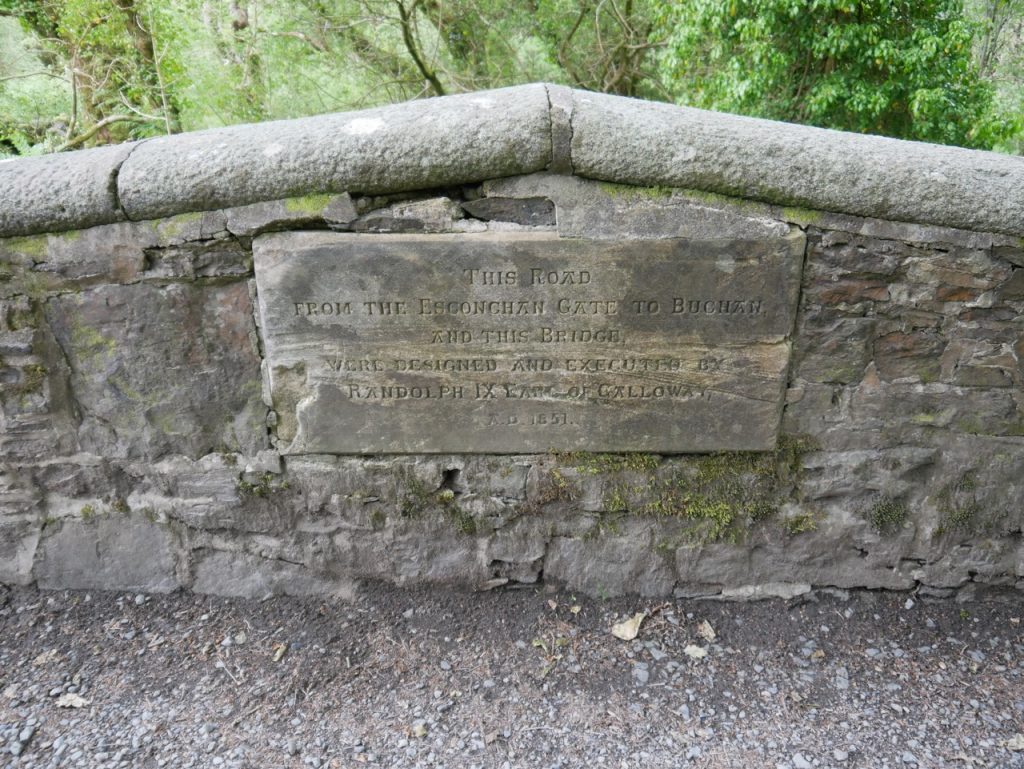
Buchan Bridge
That inscription no longer present. A less poetic inscription records that it what built in 1851. The photograph above shows what we found.
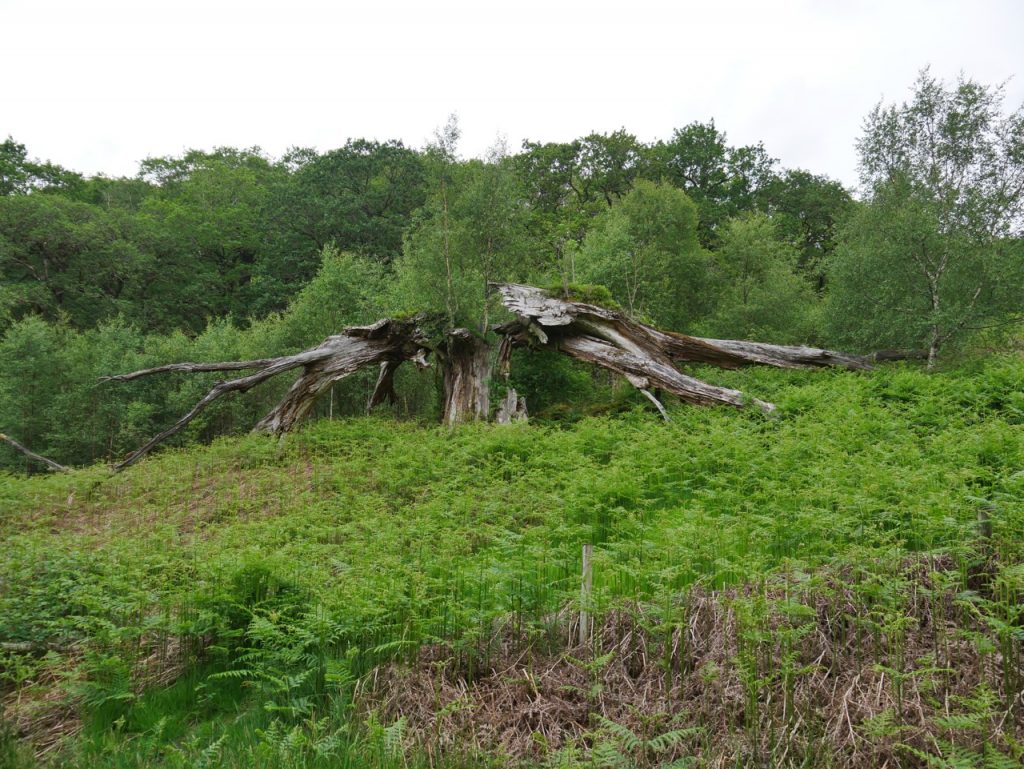
Old tree
Every post about walks here has to include a photo of this split tree. It’s a bye-law or something. I have always presumed it to have been been struck by lightning, though of course it may have been smashed by one of the giant boulders thrown in a dispute between giants. Perhaps the Giant Axe Head Stane bounced here before reaching its present resting place?
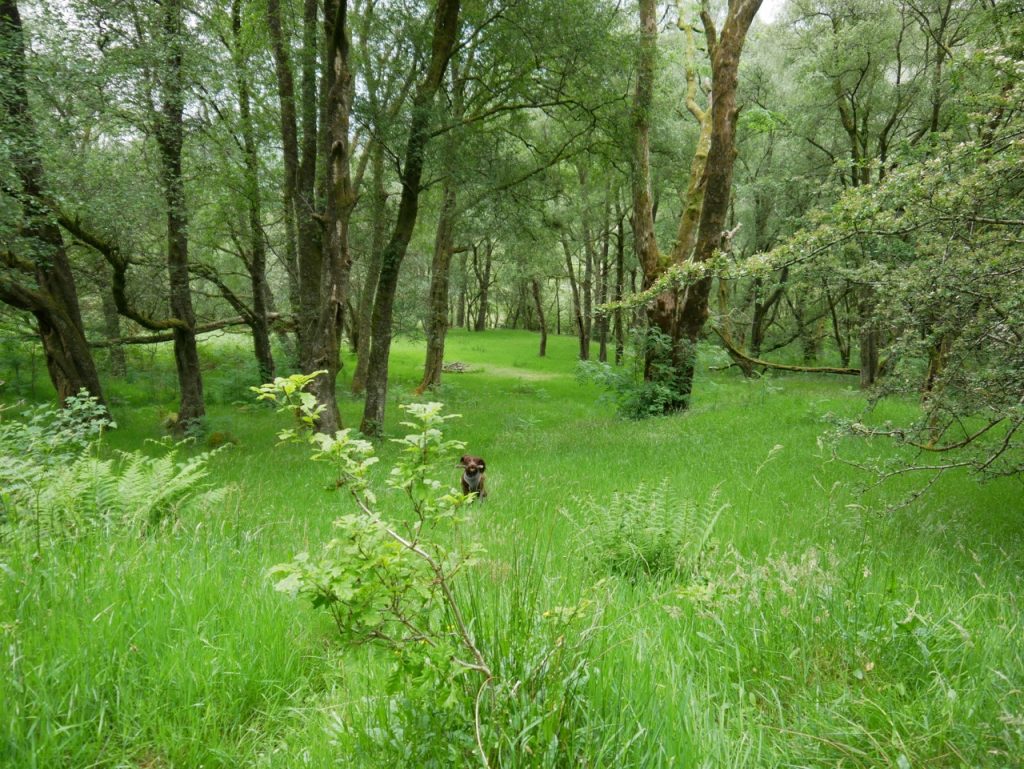
a perfect woodland glade
The short section between the Buchan and Gairland Burns is beautiful in its own right but easily overlooked. Those just setting out on their journey may be looking at the mountain-sides ahead of them and those returning have thoughts only for the end of their journey. But there is beautiful woodland, some of the trees young but with an old-timer here and there. One massive oak looked to have a circumference of four spans or more and may have been here when Malcolm Harper visited in the 1870s.
Beneath the trees there were carpets of cow-wheat, with their twinned yellow flowers. I don’t think I’ve seen such a this flower before, but it would be easy to mistake it for one of the more common yellow wildflowers if you only glanced. It is a hemiparasitic plant, it has its own rather grass-like green leaves, but also acquires nutrients from the roots of neighbouring plants. It has a special relationship with wood ants, which distribute its seeds, so think twice before you sit down in it for lunch.
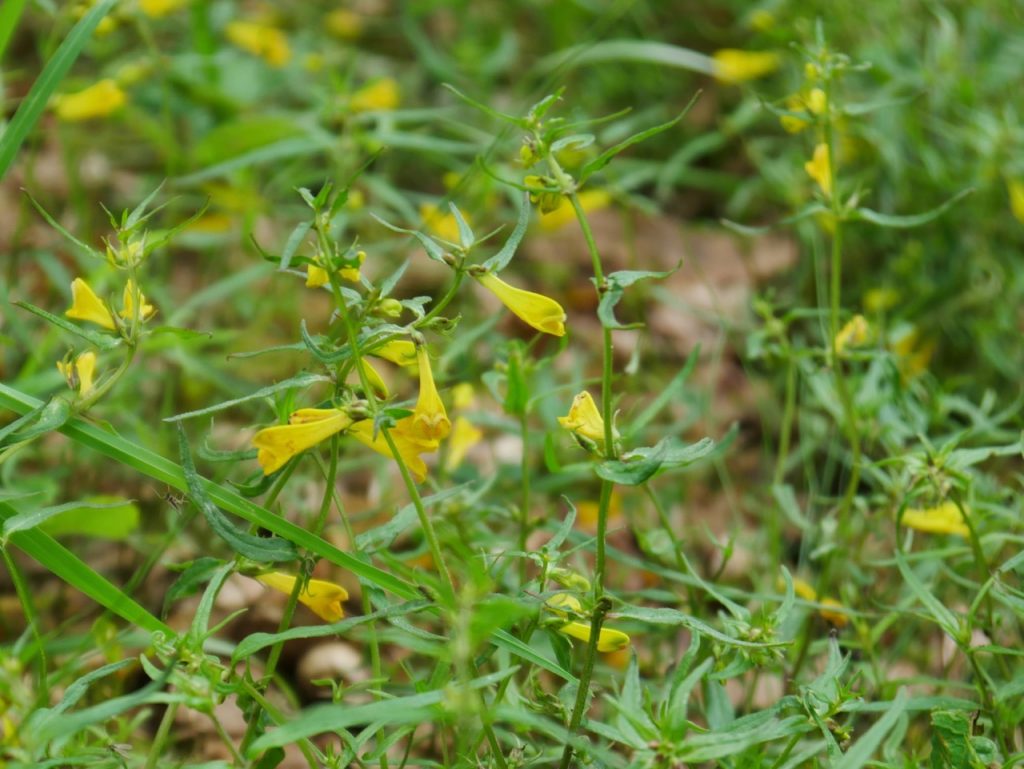
Cow wheat
There seem no end of explanations for its name, none of which are particularly convincing. Wheat itself derives its name from Old English hwæte, or a variety of similar words in Germanic and Scandinavian languages. It means white and refers to the colour of the milled grain. If cow wheat seeds are mixed with bread flour it turns the bread black, which explains its Latin name Melampyram pratense, melas (black), pyros (wheat) and pratense (meadow). But before you rush out to gather seeds for the baking of black bread be aware ‘the seeds of this herb taken in meate or drinke troubleth the braynes, causing headache and drunkennesse.’
In gaelic, cow-wheat is cáraid bhuidhe, the yellow twins. No question how it got that name, with its pairs of yellow flowers. The flowers are sometimes described as primrose yellow and sometimes as golden. And as an aside, yellow and gold have the same root *ghel, to shine, through Old English, geolu, yellow and gold, gold. Our cow-wheat was more gold than yellow.
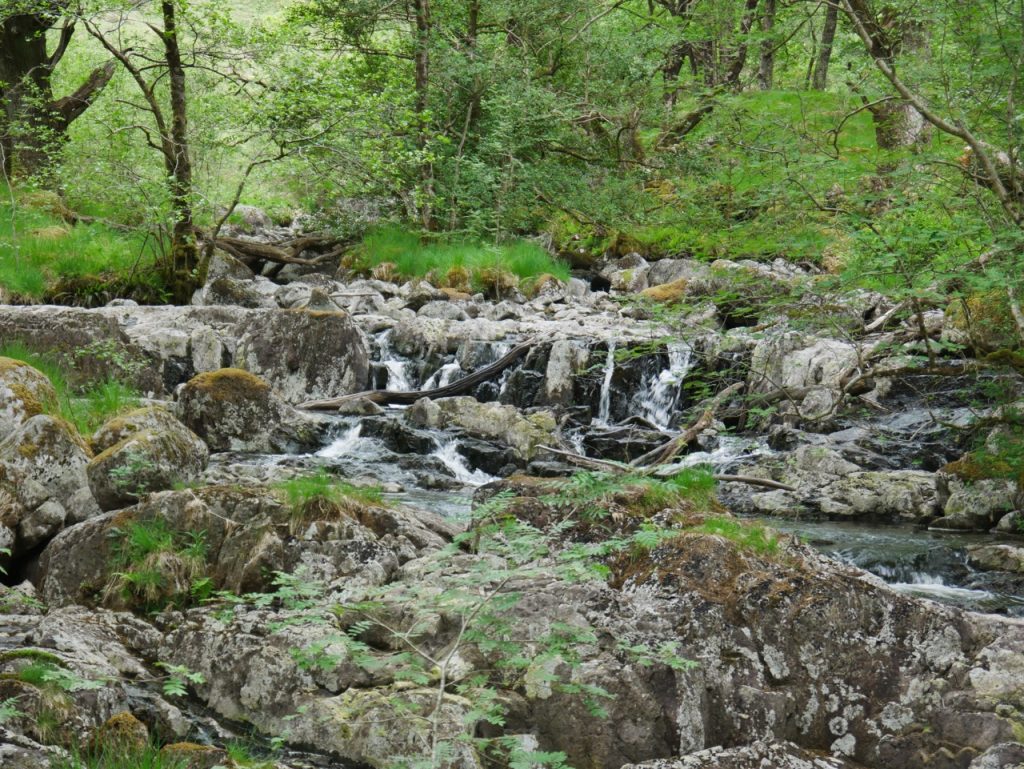
Gairland Burn
Yonder torrent glimmering white before us, whose roaring reaches the ear from far, is the Gairland Burn,
S.R. Crockett. (The Raiders)
And it was the sound of cascading water that called our attention to the Gairland Burn. Its wide open waterfalls a contrast to the steep sides at the Buchan. The Gairland’s bridge is wooden and would be at home in The Three Billy Goat’s Gruff. I strode across quickly, my feet trip-trapping across the boards, ready to tell the troll he should let me pass and wait for Audrey (her sandwiches would be tastier than mine). We crossed quickly on the outward journey but tarried to explore on the way back. Who could look at those rocky pools and not think “rough”?
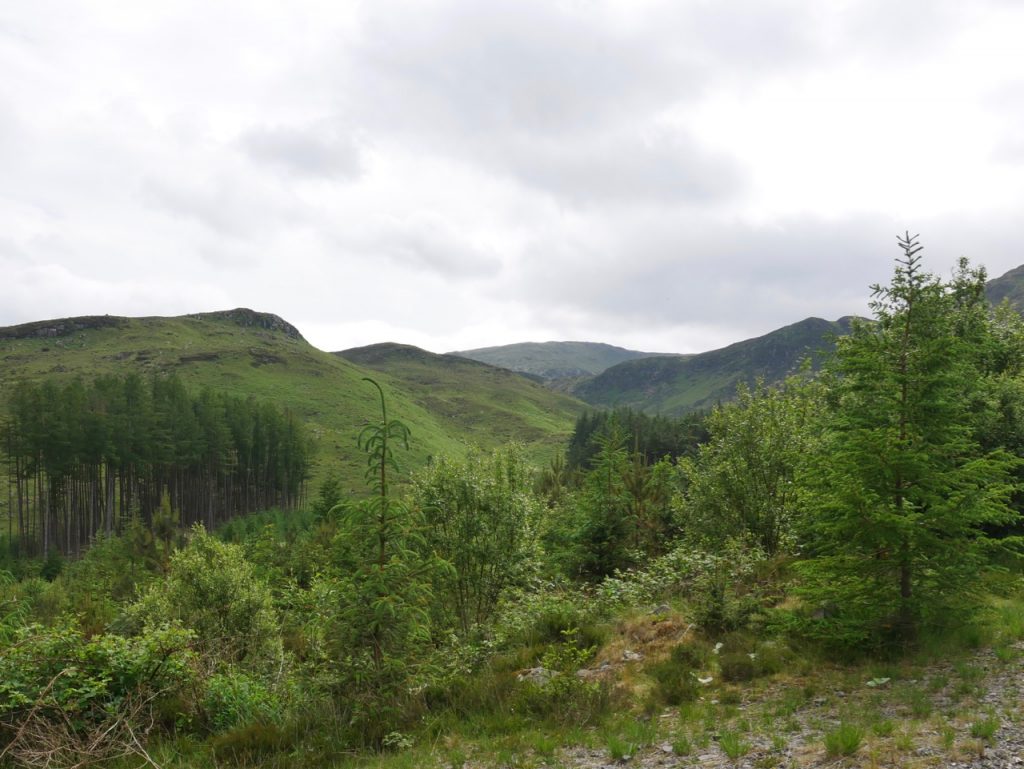
Curleywee in the distance
There was quite a bit of building work going on at Glenhead. An outdoor centre perhaps, or a religious retreat given that the boulder beside it is inscribed “Dominus Fecit” (the Lord made). But that’s also the Baird family motto, so it may be a bridgehead for an invasion of highlanders. After Glenhead the forestry track crosses the Glenhead Burn then turns to meander up the pass towards Loch Dee. We had to step aside for a glaziers van to pass us. What it was glazing out there god only knows.
The waterfalls of the Shiel Burn were still active despite the long dry spell and the lower section was visible now that the forest around it has been felled. The scent of pine reached us before we saw the stacks of logs beside the track.
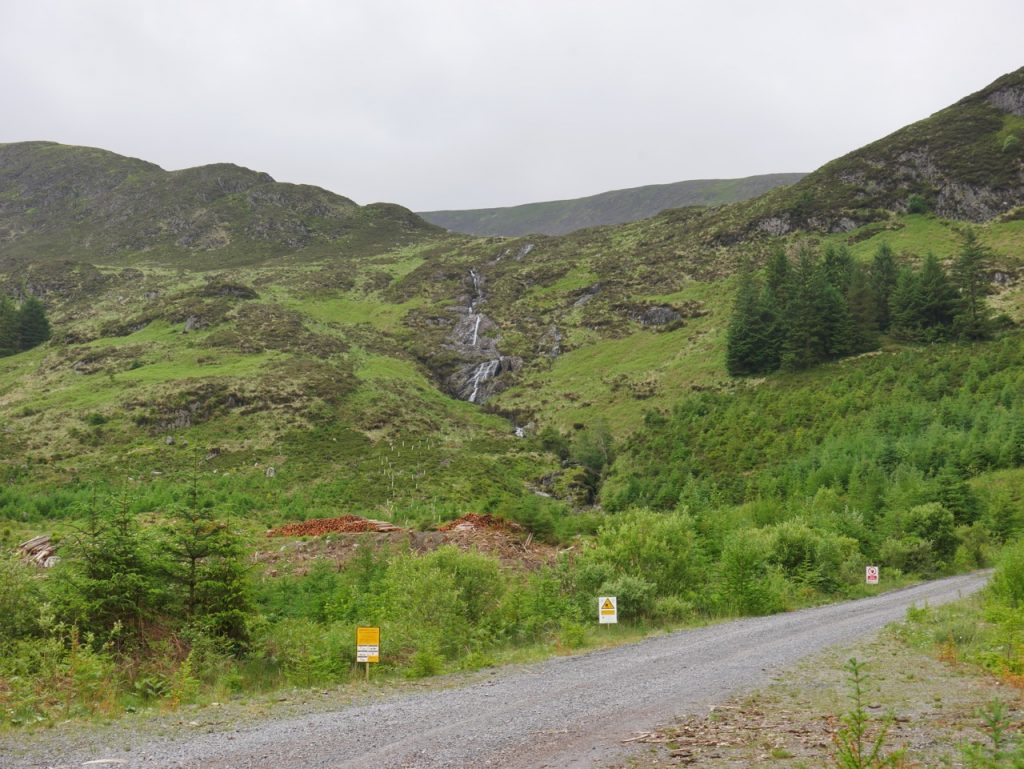
Shiel Burn, with danger of death sign, note the stacked logs
The felling has opened up some viewpoints. I have only walked this section of the SUW once previously and that was in rain and low cloud so it is difficult to know how much different.
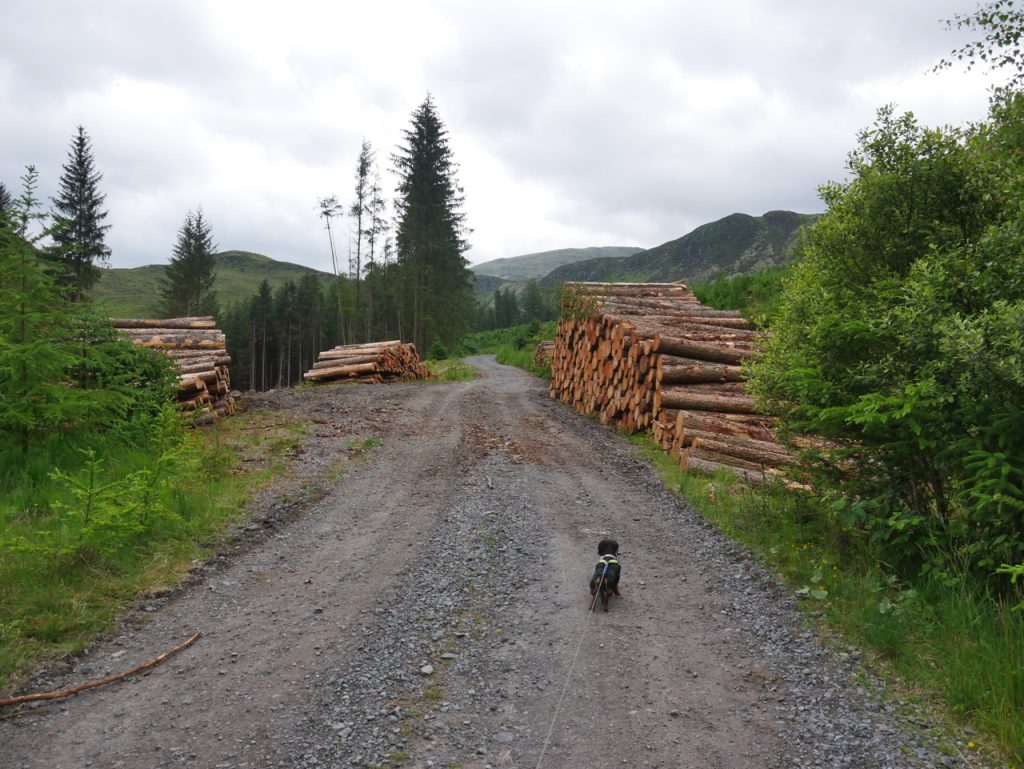
Felled trees
The forestry track runs along the pass flanked by the Corse Knowe of Glenhead and the Corse Knowe of White Laggan, with the craggy slopes of the Brishies to the right.
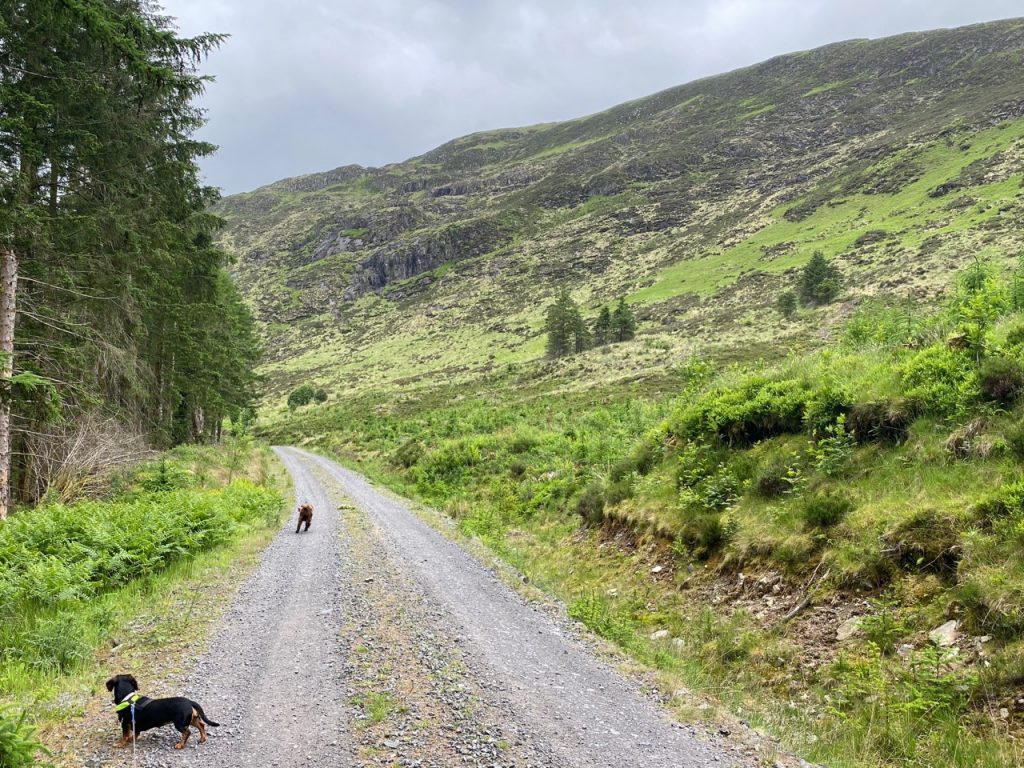
Brishies
There are several features with the name Brishies nearby. The Brishies we were walking beneath, but also The Brishie on Dungeon Hill, the Brishie Burn and the Brishie Bog. Dungeon’s Brishie is a (very) rocky shoulder/ridge and the “Brishies” below which we walked was steep mountainside with numerous crags/clints. I wonder if the root word is that which gave us brows, braes, or given Pont’s spelling something a little more gaelic like bràigh (pronounced brY). On Pont’s maps the Brishies are named Bryishyish.
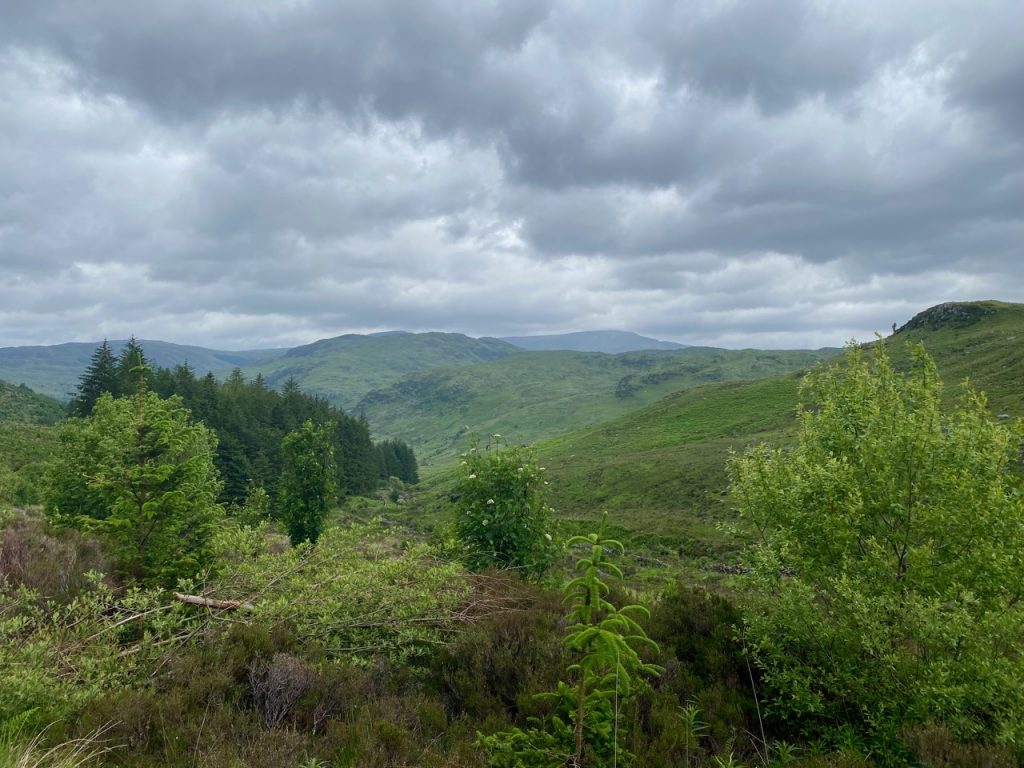
Galloway Hills
As the track climbed we had excellent views back to the Galloway hills, with Benyellary and Merrick just peeping over the tops of Buchan Hill and Craigminn.
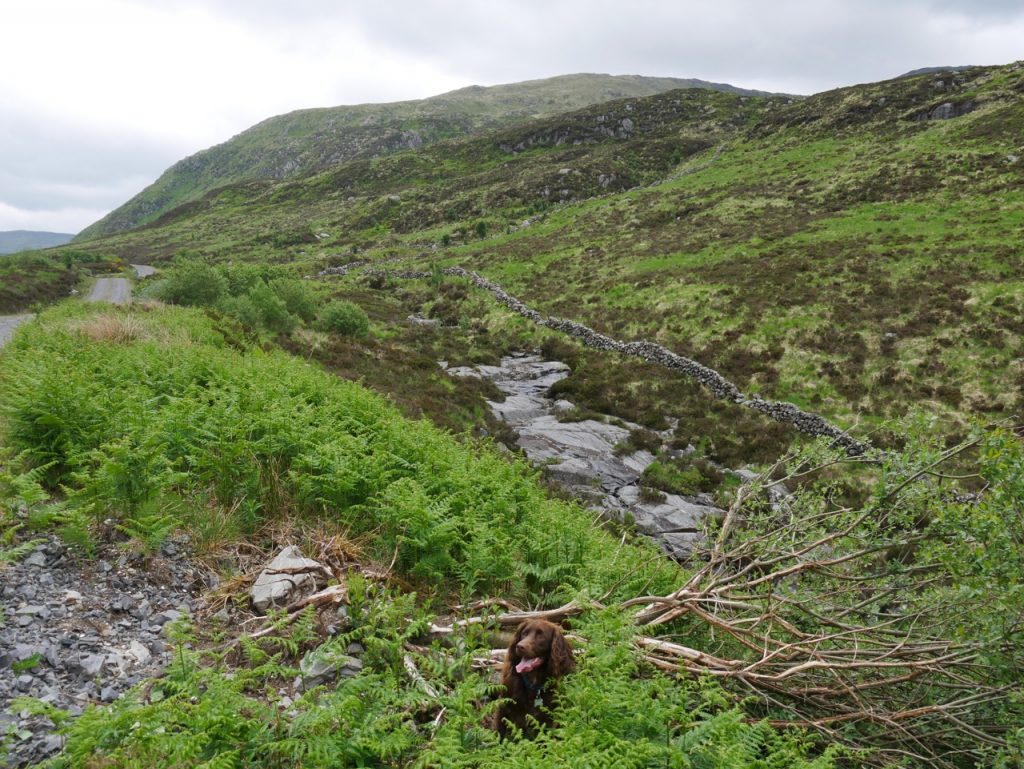
Glenhead Burn
The upper reaches of the Glenhead Burn have wide slabs of granite as a base. I decided to get a closer look. I left the girls behind on the path. Had I fallen down a hole they would have been able to summon help. But it was a bit of a slog, more uneven and steeper than I anticipated so I turned back to find it was even more uneven and steep than it had been a couple of minutes earlier. On the way back up, looking down to chose my next step, a lizard/newt slithered away from my foot. From the brief glance I had, and some later googling, I’d say it was a common lizard. I liked the wisdom of “if you can catch it, it’s a newt. If you can’t, it’s a lizard”. This fellow was pretty quick. The spaniel didn’t notice it but to be fair it wasn’t ball shaped.
There were cows on the hillsides. I could identify them.
Both the Dargall Burn, heading east into Loch Dee, and the Glenhead Burn, heading west to Loch Trool, are born on the slopes of the Corse Knowe of White Laggan, but with the majority of the water heading east while the flow was slow such as today.
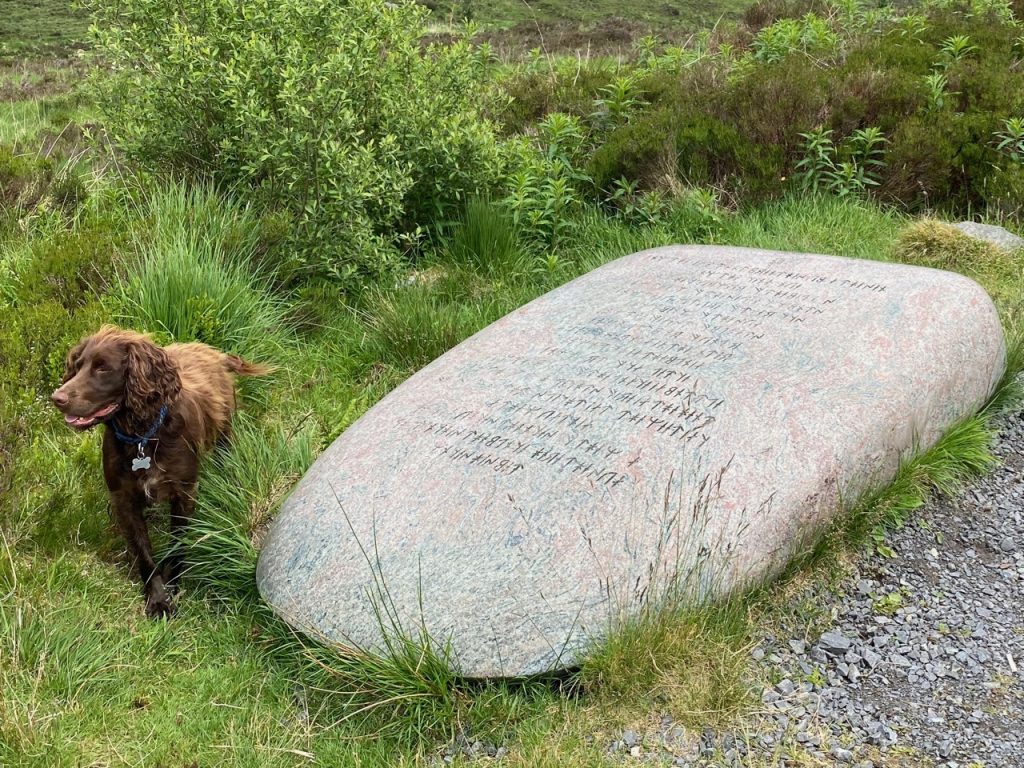
Axe Head Stane
And then we were back to the Axe Head Stane again. Last week I posted a translation of the runic poem inscribed on it, but I had found different translations of the Mystery of Amergin and began to wonder which one it was on this stone. So I got out my photographs and set about finding what the runes actually spelt out. The runes are most like the Younger Futhark runes, though there are a couple of Elder Futhark runes thrown in. The lines reading left to right. The runes’ shapes are modernised with some of their straight lines now curved, as with ᛒ which shown like a B, and the inscription’s runes are flipped horizontally, so the B is like a ᘀ (that’s the closest I could render). The rune for k occurs in two forms, one representing a hard K, the other a soft C. O is shown as an empty space.
For reasons that escape me, the first line I tried to decode was the last which read “makes his bed”. That had me flummoxed at first until I realised it is just the second part of the last ‘poetic’ line. Anyway here is the inscription:
I am the wind that breathes upon the sea,
I am the ocean wave
I am the murmur of the billows
I am the elk of the seven combats
I am the vulture of the rocks
I am a beam of the sun
I am the finest of plants
I am a wild boar of valour
I am a salmon in the water
I am a loch in the plain
I am a word of knowledge
I am the point of the lance in battle
I am the God who lights fire in the head
Who is it who throws light into the meeting
on the mountain
Who announces the ages of the moon
Who teaches the place where the sun
makes his bed
Something has been lost in translation. A modern ear may follow the words, but we have lost some of the symbolism its original listeners would have easily grasped. Each of the subjects mentioned would have carried an additional meaning much as we might attribute cunning to the fox, protection and loyalty to a dog or wisdom to an owl.
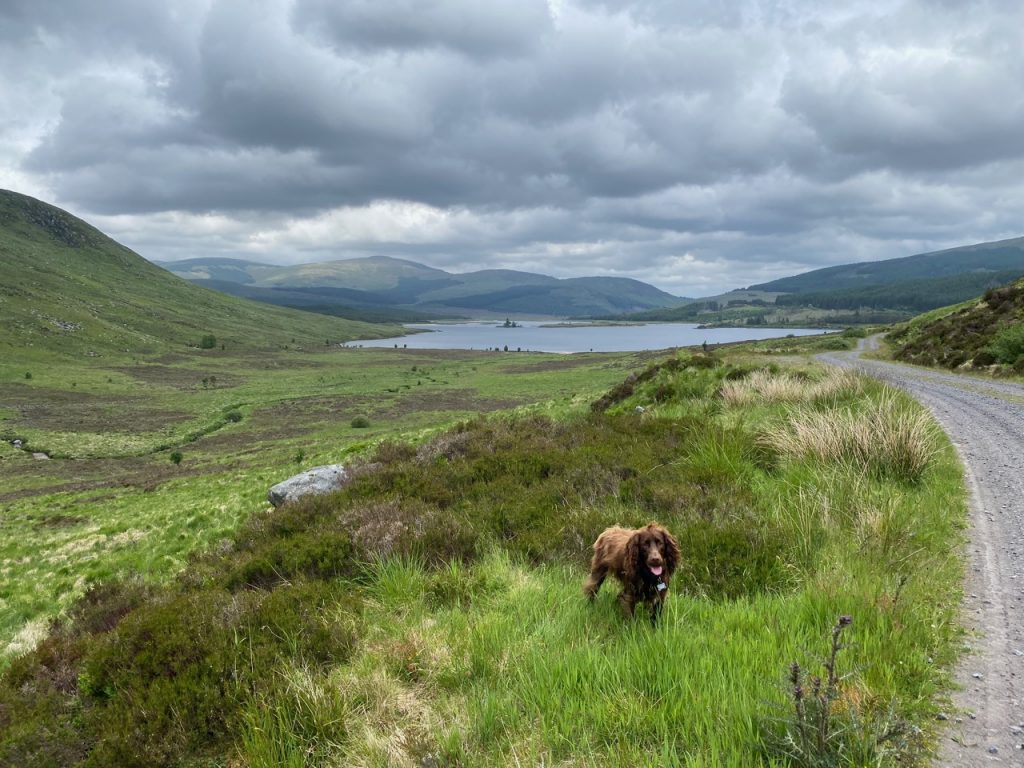
Loch Dee
We continued down along the road until we reached the Rosnes benches again. We had our lunch in the same place as we had a week earlier though some impulse made me sit on the other bench this week.
Christy doesn’t like stopping when we are out on a walk and once we settled down he got more animated, digging up roots and throwing them to me, so they could be thrown and fetched. I have tried giving him a ball in similar circumstances but that makes matters even worse.
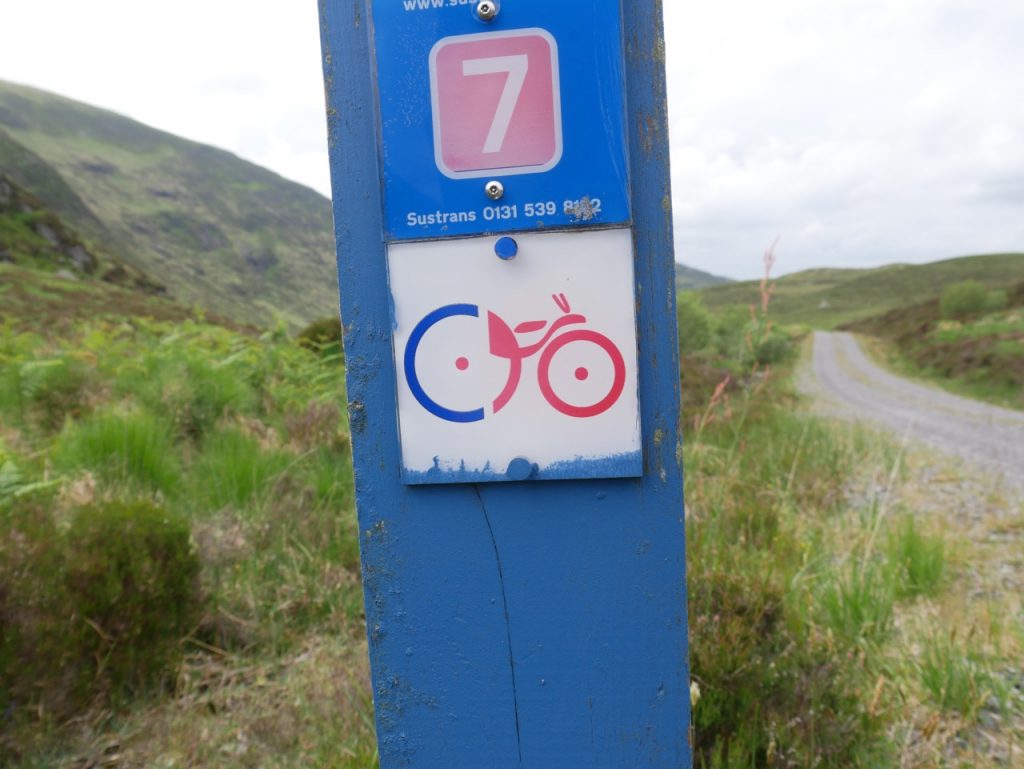
weird cycle sign
After lunch we retraced our steps enjoying the views in reverse. The national cycleway signs I’ve seen on the SUW don’t have the usual bicycle sign, instead having this one with unequal wheels. I’ve spent I do know how much time trying to find its significance. In vain. Well, enough is enough. I’ve emailed them. [response awaited]
Back at the Gairland Burn we followed a faint track leading up beside the burn a little way so we could explore the rocks. I think this is the lowest I’ve seen the water in this burn. It would have been easy enough to cross on the exposed rocks without getting wet feet. The dogs don’t care about wet feet and paddled as they had in the Glenhead burn a few minutes earlier.
We finished with a visit to Bruce’s Stone above the loch. I’ll leave Malcolm Harper to describe the views.
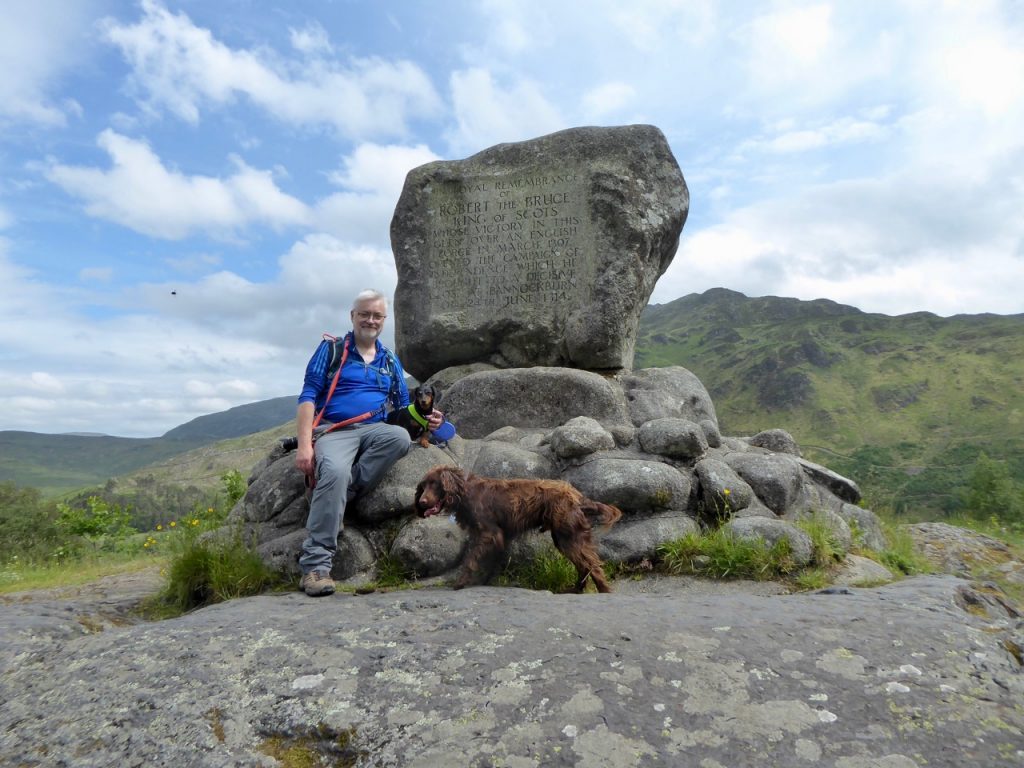
Bruce’s Stone
The romantic glen of Trool has long been a favourite resort of the lovers of picturesque scenery ; and it is deservedly acknowledged by all who have visited it to be the finest Highland scene in the south of Scotland, and not inaptly termed the Southern Trossachs. Not many years ago the distinguished orator and statesman, Mr. Bright, visited this district, and, it is said, was so enchanted with the scene that he gave vent to his feelings in the lines : —
‘Land of the mountain, strath, and stream, Is it reality or but a dream ? ”
Rambles in Galloway (1876) Malcolm Harper


I enjoyed reading this
as I did this very walk only about a month or so ago.
It was good to get a translation of the runes, which is about where I got to. I turned around and went back from here and only when I turned did I see the Merrick and Ben Yellery over the brow of the nearer hill!
I also enjoyed seeing the waterfalls of the Corse Knowe of White Laggen which started at the top of the brow of the hills, looking quite impressive; strangely named as its completely round the hill from the old While Laggan; now a bothe, but originally was a farm house used by my Great Great grandparents. My mother used to tell me how Great Great grandma Hunter used to get break in the summer by wrapping up her youngest, taking a sack of oats and would walk up via Drigmorn (with a pony?) and stay at White Laggan for a month. A lovely story. Hard to pin down exactly which Ancester it was (exactly how may “Greats”!).
I now live in Newton Steward since August, having visited here for very many years since I was 2 yrs old in 1957 (originally by train to Newton Stewart).
I couldn’t find your name on the website.
Walking up Drigmorn! They were hardy back then.
PS I’m in Dumfries.